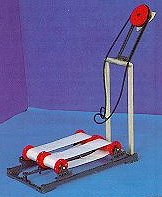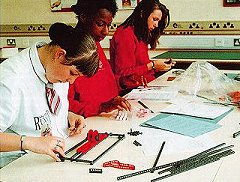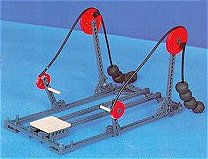
|
Feedback Form


SPORT DESIGN BRIEF

Increasingly sport has become a high tech activity involving state of the art technology, materials, processes and machines. Design Brief Levels 4-7. To research and evaluate a piece of sports equipment which uses a mechanism to make it work. Study its design, structure, mechanism and construction. Then based on your research design a piece of human powered sports equipment. Design Brief Levels 6-10. Fulfil all the criteria for the above brief then make a model to explain and demonstrate your design.
This was the design brief given to 14 year old girls at Burntwood School, Tooting. In addition Pete Jewett, their teacher, asked them to include as many mechanisms and types of motion as possible. Here he explains the design process.
In preparation, they investigated the properties of levers, linkages, cams, cranks, sliders, gears and pulleys. The Inventa book of mechanisms was really appreciated at this point since it approached the knowledge in a lively and fun way, yet instilled a fundamental understanding of how the mechanisms worked.
 
|
Driscelle, Rosalee, Thembe, Vanessa and Luisa collected examples of brochures of existing sports equipment such as rowing machines and stepping machines in order to study how they worked. Once they had analysed them mechanically they set about designing their own. As an athlete, Rosalee had a great understanding of the functions of the machines which she tried to show in her own designs.
Once the machines had been refined and the best designs discussed and decided upon the pupils set about making them. Seeing all the parts helped the girls to choose appropriate mechanisms for their machine. Vanessa soon realised that a fixed rack would be a very useful basis for her rowing machine and Luisa experimented with linkages formed by the link strip. The girls constantly reappraised their designs, pulling them apart and trying another method.
It was intriguing to watch the girls solve problems posed by their structures through the Inventa system, for instance using corner gussets for triangulation. They were learning about structures in a very positive and fulfiling way. It also made the accurate inclusion of mechanisms very easy.
I was pleased to see that the pupils were not limited by the size of the parts but automatically sawed them to size and adapted them to their needs. This allowed a wide variety of outcomes. The flexibility of the system also allowed other materials to be introduced into their designs. They enjoyed the possibilities it gave them and removed the frustrations associated with their realisation.
They, too were very pleased with their efforts. Rosalee's comment of "I really like the way you can do lots of things with it," and Vanessa's of "It looks nice when it's assembled," sum up the satisfaction they felt. Inventa enabled us to produce high quality outcomes in an educational and creative way. I feel that it has an assured place in technology classrooms for pupils of all ages.
| Back |
|---|